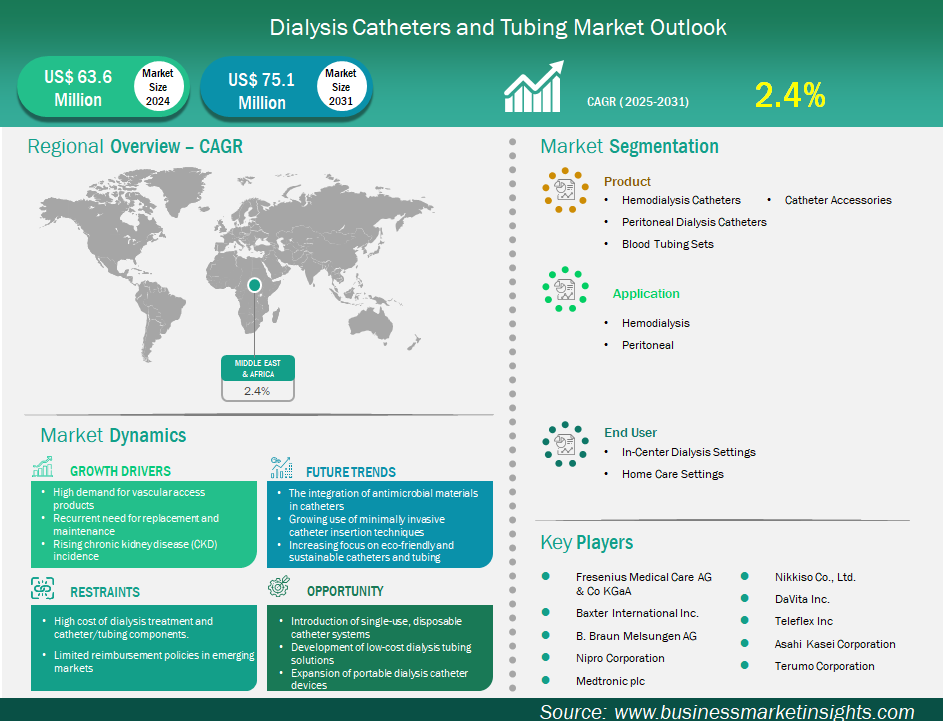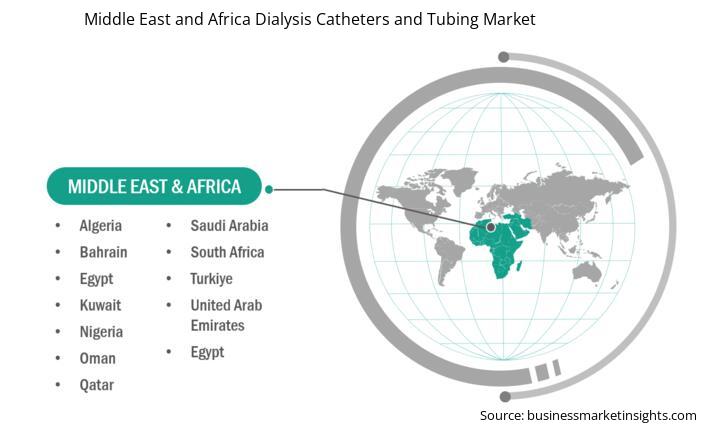Middle East and Africa Dialysis Catheters and Tubing Market Outlook (2021-2031)
No. of Pages: 166 | Report Code: BMIPUB00032276 | Category: Life Sciences
No. of Pages: 166 | Report Code: BMIPUB00032276 | Category: Life Sciences
The Middle East and Africa dialysis catheters and tubing market size is expected to reach US$ 75.1 million by 2031 from US$ 63.6 million in 2024. The market is estimated to record a CAGR of 2.4% from 2025 to 2031.
The dialysis catheters and tubing market in the Middle East and Africa is experiencing significant growth driven by high demand for vascular access products, recurrent need for replacement and maintenance, and rising chronic kidney disease (CKD) incidence. The dialysis catheters and tubing market across the Middle East and Africa (MEA) is dynamic, showing rapid growth in some segments and significant differences in healthcare infrastructure. The market analysis reflects that the increase in the number of various non-communicable diseases, such as diabetes and hypertension, resulting in a high incidence of chronic kidney disease (CKD), is the primary driver of the market. The demand for advanced products to reduce patient complications has shifted in preference from catheters made of silicone or polyurethane to those made of antimicrobial-coated. This preference for antimicrobial-coated catheters is seeing a premium placed on products in areas where there is a higher risk of hospital-acquired infections. The competitive landscape comprises global medical device manufacturers and local medical distributors. Factors such as high per capita healthcare spending and a focus on preferred products in the Middle East make this region quite different than Africa, where healthcare is generally more focused on affordability and accessibility. The difference in priorities and the dual marketing focus present unique challenges for companies and will require a dual-pronged approach to market successfully across both regions. The market in the MEA also includes government initiatives to improve access and quality through investment in new dialysis centers and capital equipment.

Key segments that contributed to the derivation of the dialysis catheters and tubing market analysis are product, application, and end user.
The Middle East and Africa dialysis catheters and tubing market is segmented into Turkiye, the United Arab Emirates, Saudi Arabia, Bahrain, Oman, Egypt, South Africa, Algeria, Nigeria, Kuwait, and Qatar. The MEA dialysis catheters and tubing market has a promising future, driven by several trends. The increasing CKD cases will bring new patients into the system and increase the demand for dialysis products. There is a clear movement toward home-based dialysis in several more developed countries in the Middle East, especially peritoneal dialysis, as healthcare systems leverage this method to enhance quality of life and lessen burden on in-center clinics, which will present a new demand segment for reliable, user-friendly tubes and catheters. Africa's outlook will depend on growth in healthcare infrastructure and partnered private-public endeavors to make dialysis more accessible. Technological advancement, such as building better, portable, long-lasting products, will continue to grow, given the specific challenges the region needs to deal with regarding limited access to specialist health clinics and durable solutions for continual use.
Based on country, the Middle East and Africa dialysis catheters and tubing market is further segmented into Turkiye, the United Arab Emirates, Saudi Arabia, Bahrain, Oman, Egypt, South Africa, Algeria, Nigeria, Kuwait, and Qatar. Turkiye held the largest share in 2024.
The MEA dialysis market is extremely fragmented, with each country having different market drivers and challenges. In the Middle East, Turkiye, Saudi Arabia, and the United Arab Emirates are the key markets, supported by large healthcare budgets and a strong focus on quality and high-volume imported medical technology. These markets have created a strong basis for dialysis centers and have reimbursement policies favorable for the adoption of premium products. South Africa is particularly dominant on the African continent, with a more established healthcare system with a larger relative patient population, although equity of access remains challenging. Other African countries, such as Egypt and Nigeria, represent large potential markets where population size and increased access to basic healthcare services are the main growth drivers. These countries are more focused on affordable, high-volume products than premium products. The purchasing dynamics in each country depend on government healthcare expenditure and the extent of CKD concerning existing healthcare in each country.
| Report Attribute | Details |
|---|---|
| Market size in 2024 | US$ 63.6 Million |
| Market Size by 2031 | US$ 75.1 Million |
| CAGR (2025 - 2031) | 2.4% |
| Historical Data | 2021-2023 |
| Forecast period | 2025-2031 |
| Segments Covered |
By Product
|
| Regions and Countries Covered | Middle East and Africa
|
| Market leaders and key company profiles |
|
Fresenius Medical Care AG & Co KGaA; Baxter International Inc.; B. Braun SE; Nipro Corp; Medtronic Plc, Nikkiso Co Ltd, Teleflex Inc, Asahi Kasei Medical Co., Ltd., Terumo Corp, and DaVita Inc., are among the key players operating in the market. These players adopt strategies such as expansion, product innovation, and mergers and acquisitions to stay competitive in the market and offer innovative products to their consumers.
The following methodology has been followed for the collection and analysis of data presented in this report:
The research process begins with comprehensive secondary research, utilizing both internal and external sources to gather qualitative and quantitative data for each market. Commonly referenced secondary research sources include, but are not limited to:
Note: All financial data included in the Company Profiles section has been standardized to US$. For companies reporting in other currencies, figures have been converted to US$ using the relevant exchange rates for the corresponding year.
Business Market Insights conducts a significant number of primary interviews each year with industry stakeholders and experts to validate and analyze the data and gain valuable insights. These research interviews are designed to:
Primary research is conducted via email interactions and telephone interviews with industry experts across various markets, categories, segments, and sub-segments in different regions. Participants typically include:

The Middle East and Africa Dialysis Catheters and Tubing Market is valued at US$ 63.6 Million in 2024, it is projected to reach US$ 75.1 Million by 2031.
As per our report Middle East and Africa Dialysis Catheters and Tubing Market, the market size is valued at US$ 63.6 Million in 2024, projecting it to reach US$ 75.1 Million by 2031. This translates to a CAGR of approximately 2.4% during the forecast period.
The Middle East and Africa Dialysis Catheters and Tubing Market report typically cover these key segments-
The historic period, base year, and forecast period can vary slightly depending on the specific market research report. However, for the Middle East and Africa Dialysis Catheters and Tubing Market report:
The Middle East and Africa Dialysis Catheters and Tubing Market is populated by several key players, each contributing to its growth and innovation. Some of the major players include:
The Middle East and Africa Dialysis Catheters and Tubing Market report is valuable for diverse stakeholders, including:
Essentially, anyone involved in or considering involvement in the Middle East and Africa Dialysis Catheters and Tubing Market value chain can benefit from the information contained in a comprehensive market report.